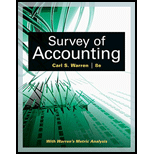
Concept explainers
Concept Introduction:
Financial statements:
Financial statements are prepared to summaries the account at the end of the period. The statements prepared are Income statement,
Balance Sheet:
The Balance sheet is a summary of Assets, Liabilities and equity accounts that reports the financial position of the business as on a specific date. Assets are further classifies into Current Assets, Long Term Investments, Plant Assets and Intangible assets. And Liabilities are further classified into Current Liabilities and Long term liabilities.
Basic Earnings per share:
The Basic Earnings per share is the amount of net income earned by each common share outstanding. The Earnings per share calculated by with help of following formula:
To Indicate:
The effect of Payment of Dividend on Net Assets and Earnings per share
Want to see the full answer?
Check out a sample textbook solution
Chapter 8 Solutions
Survey of Accounting (Accounting I)
- Answer 1 and 2 please!!! here is the data you needf: Month Monthly Product Demand 2021-01-01 100.32 2021-02-01 102.57 2021-03-01 103.32 2021-04-01 104.45 2021-05-01 108.78 2021-06-01 110.10 2021-07-01 112.99 2021-08-01 113.27 2021-09-01 108.22 2021-10-01 107.20 2021-11-01 114.90 2021-12-01 117.88 2022-01-01 104.92 2022-02-01 112.06 2022-03-01 112.56 2022-04-01 109.18 2022-05-01 111.41 2022-06-01 112.62 2022-07-01 122.41 2022-08-01 124.90 2022-09-01 111.65 2022-10-01 115.37 2022-11-01 120.23 2022-12-01 120.64 2023-01-01 106.34 2023-02-01 115.43 2023-03-01 119.18 2023-04-01 110.58 2023-05-01 112.89 2023-06-01 117.91 2023-07-01 123.61 2023-08-01 128.75 2023-09-01 117.18 2023-10-01 124.42 2023-11-01 128.22 2023-12-01 121.14 2024-01-01 108.70 2024-02-01 120.23 2024-03-01 130.26 2024-04-01 115.35 2024-05-01 116.74 2024-06-01 128.81 2024-07-01 130.88 2024-08-01 132.19 2024-09-01 129.45 2024-10-01…arrow_forwardWhat is the total stockholder's equity at the end of 2024 on these financial accounting question?arrow_forwardI want the correct answer with accounting questionarrow_forward
- what is Orion's total asset turnover ratio? accounting question solutionarrow_forwardSummit Industrial forecasts that total overhead for the current year will be $8,500,000 and that total machine hours will be 150,000 hours. Year-to-date, the actual overhead is $5,600,000, and the actual machine hours are 75,000 hours. If Summit Industrial uses a predetermined overhead rate based on machine hours for applying overhead, what is the overhead rate? a. $50 per machine hour b. $65 per machine hour c. $56.67 per machine hour d. $45 per machine hourarrow_forwardSunTech Energy has total sales of $1,500 and costs of $850. Depreciation is $200, and the tax rate is 30%. The firm does not have any interest expense. What is the operating cash flow (OCF)?arrow_forward
- Swift Manufacturing has a predetermined overhead rate of $5 per machine hour. Last year, the company incurred $125,500 in actual manufacturing overhead costs, and the account was $6,000 over- applied. How many machine hours were used during the year? a. 22,700 machine hours b. 26,500 machine hours c. 27,100 machine hours d. 26,300 machine hoursarrow_forwardSubject=Accounting solutionarrow_forwardA printing company has variable expenses equal to 30% of sales and monthly fixed expenses of $180,000. The monthly target operating income is $90,000. What is the operating leverage factor at the target level of operating income?arrow_forward
 Survey of Accounting (Accounting I)AccountingISBN:9781305961883Author:Carl WarrenPublisher:Cengage Learning
Survey of Accounting (Accounting I)AccountingISBN:9781305961883Author:Carl WarrenPublisher:Cengage Learning Managerial AccountingAccountingISBN:9781337912020Author:Carl Warren, Ph.d. Cma William B. TaylerPublisher:South-Western College Pub
Managerial AccountingAccountingISBN:9781337912020Author:Carl Warren, Ph.d. Cma William B. TaylerPublisher:South-Western College Pub Financial And Managerial AccountingAccountingISBN:9781337902663Author:WARREN, Carl S.Publisher:Cengage Learning,
Financial And Managerial AccountingAccountingISBN:9781337902663Author:WARREN, Carl S.Publisher:Cengage Learning, Managerial Accounting: The Cornerstone of Busines...AccountingISBN:9781337115773Author:Maryanne M. Mowen, Don R. Hansen, Dan L. HeitgerPublisher:Cengage Learning
Managerial Accounting: The Cornerstone of Busines...AccountingISBN:9781337115773Author:Maryanne M. Mowen, Don R. Hansen, Dan L. HeitgerPublisher:Cengage Learning Financial AccountingAccountingISBN:9781337272124Author:Carl Warren, James M. Reeve, Jonathan DuchacPublisher:Cengage Learning
Financial AccountingAccountingISBN:9781337272124Author:Carl Warren, James M. Reeve, Jonathan DuchacPublisher:Cengage Learning Cornerstones of Financial AccountingAccountingISBN:9781337690881Author:Jay Rich, Jeff JonesPublisher:Cengage Learning
Cornerstones of Financial AccountingAccountingISBN:9781337690881Author:Jay Rich, Jeff JonesPublisher:Cengage Learning





